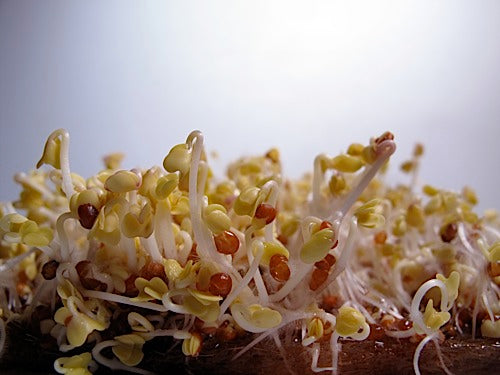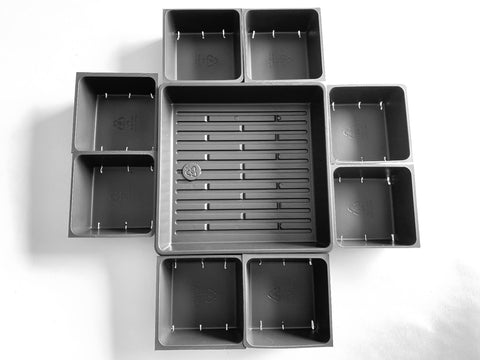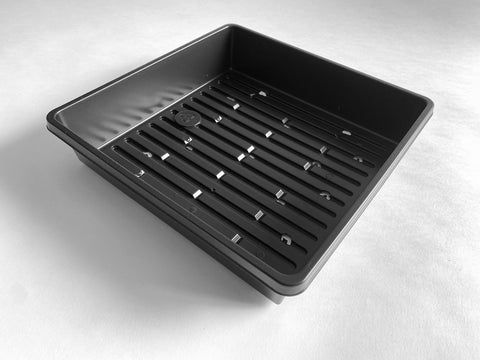


Broccoli Micro-Greens
The most famous sprout in America? Mild flavor, mild crunch, big time nutrition - here in the form of a Micro-Green. Easy to grow.
Note: This is the same seed we sell for Broccoli Sprouts.
Vitamins A, B, C, E and K
Calcium, Iron, Magnesium, Phosphorus, Potassium, Zinc
Carotene, Chlorophyll, Trace Elements, Amino Acids
Antioxidants
Protein: 35%
Mildly spicy and extremely tender.
The time it takes to grow a finished 5 - 14 days, or other crop (Micro-Greens, Grass, Greens) from a dry Seed. Note: This "finished" Sprout is our preference. you may grow them for as long as you want! In fact, we suggest that you taste them at every rinse to discover when you like them best.
How to Grow Broccoli Micro-Greens
- Plant 1-2 teaspoons of seed (for a 5x5 inch Tray) on thoroughly moistened medium.
- Cover your crop with another tray, or a plate - to keep light out and moisture in.
- Keep your medium moist by watering lightly as needed. Don't drench!
Use Coconut Coir and you likely won't have to water at all after planting! - When your plants have begun to show leaves, remove cover and move your crop to a well lit location.
- Harvest when the leaves are open and an inch or three tall (day 5-14).
- Cut just above the medium, with a scissors or sharp knife.

Broccoli spread atop the thoroughly moistened medium of our choosing - Baby Blanket in this instance.

24 - 48 hours later... Broccoli is pretty fast to germinate.

24 hours later.... You will get a great education as regards Root Hairs too - which is typical of many crops, including Brassicas.

24 hours later....

24 hours later....

24 hours later....

24 hours later....

24 hours later... Harvest now - or go over the Notes Section (just below the Sprouting instructions) and take your education, and your Broccoli, further.

Broccoli spread atop the thoroughly moistened medium of our choosing - Baby Blanket in this instance.

24 - 48 hours later... Broccoli is pretty fast to germinate.

24 hours later.... You will get a great education as regards Root Hairs too - which is typical of many crops, including Brassicas.

24 hours later....

24 hours later....

24 hours later....

24 hours later....

24 hours later... Harvest now - or go over the Notes Section (just below the Sprouting instructions) and take your education, and your Broccoli, further.
Yields approximately 4 Cups (1/2 lb.) of Sprouts
Seed Prep
Measure out 2 Tablespoons of seed* (slightly heaping) into your Sprouter or a strainer.
Rinse your seeds to remove dust and debris.
Soak
Transfer your seeds into your Sprouter (if necessary), or to a bowl.
Mix seeds up as you slowly add water to assure even water contact for all.
Add 2-3 times as much cool (70-80°F) water.
Allow seeds to Soak for 4-12 hours.
Do Not Ever Soak Again. Soaking is done only this one time.
We start counting days at this point - when the Soak is done (post-Soak is the phrase we use).
A crop of Leafy Sprouts usually takes 6 days - from This point in time to harvest.
Sprouting
Empty the seeds into your Sprouter (if necessary).
Drain off the soak water.
You can use it - it has nutrients in it. We use it on house plants.
Rinse thoroughly with cool (70-80°F) water.
Drain thoroughly.
Draining Thoroughly (Maniacally even) is the key to great crops. The smaller the seed (all Leafy Sprouts are small seeds) the more thorough you must be. Do Not skimp on Rinsing - but focus seriously on Draining.
If you need to see what we mean by Thorough Draining - check out our videos.
Set your Sprouter anywhere out of direct sunlight and at room temperature (70° is optimal) between Rinses.
This is where your sprouts do their growing. We use a counter top - in the corner of our kitchen, where the sprouter won't get knocked over by cats, dogs, kids or us. Indirect sunlight is fine, as is your regular room light - because light just does not matter much in the first couple days.
A plant can only perform photosynthesis when it has leaves. Until a plant has leaves, light has little if any effect. Sprouts also happen to like air-circulation, so don't hide your sprouts. When leaves do appear, this will be plenty of light for them to green up. You can also use Grow Lights if you like.
Rinse and Drain again every 8-12 hours for 3 days.
Always be sure to Drain very thoroughly. The most common cause of inferior sprouts is inadequate drainage. Even the best designed Sprouting Device holds water, so pay special attention to this step.
Greening
On the 4th day (post soak) relocate your sprouts, if necessary.
If you've been keeping them away from light - move them. Avoid direct sun as it can cook your sprouts, unless you are growing in a Tray Sprouter - in which case direct sunlight is great. Indirect sunlight is best for non-tray Sprouters but grow lights work well too. Experiment - you will be amazed at how little light sprouts require to green up. Photosynthesis is a marvel!
Continue to Rinse and Drain thoroughly every 8-12 hours.
Your last Rinse and Drain will be either at the end of day 5 or the start of day 6.
Always Drain Thoroughly.
Finishing
Your sprouts will be done about the end of day 6.
The majority of sprouts will have open leaves which will be green. You'll recognize them.
De-Hulling
Hulls are the thin coat on a seed. In most cases they separate themselves from the sprout. They are only a problem when it comes to the shelf life of your finished crop. We've eaten them for years and consider them extra roughage, but the crop looks better and lasts longer without them - so removing them is good.
You may De-Hull your sprouts at any time during day 5 or 6.
If you have a Salad Spinner - De-Hulling can be your last step. You can harvest and refrigerate them immediately after you finish.
You can also remove hulls prior to harvest...
If you are growing in a Jar - using the Coarse Mesh Screen will allow some hulls to float out through the screen while Rinsing. Repeating and agitating your sprouts will allow more hulls to escape.
If you're growing in an Easy Sprout Sprouter - transfer your sprouts to the Solid Base, fill with water, and agitate with a fork. This will help hulls get to the surface - where you can skim them off. When you've gotten all you can - move your sprouts back to the Growing Vessel, Rinse again, and Drain Thoroughly.
If you're growing in our Stainless Steel Sprouter you can get rid of most of the hulls by Rinsing Upside Down. Instead of writing words - let us direct you to our short video on the subject: Rinsing Leafy Sprouts Upside Down
Here is our video on De-Hulling.
Harvest
If you De-hulled with a salad spinner - you can go right to refrigeration. If not... Your sprouts are done 8-12 hours after your final Rinse and Very Thorough Draining. If we minimize the surface moisture of our sprouts they store much better in refrigeration, so we let them sit for 8-12 hours after that final Maniacal Draining.
Storing Your Crop
Transfer your sprout crop to a plastic bag or the sealed container of your choice. We have Produce Storage Bags that can extend shelf life substantially.
Leafy Sprouts are best within a week of harvest, but we've had some crops last for over a month in the fridge.
Great work sprout farmer!
*Amount of Seed to Use
* If using Sproutpeople's Single Harvest Pack - use the whole bag (for a one-quart Sprouter). It will produce a crop of approximately 8 ounces.
These seeds yield approximately 7:1 - which means the sprouts will weigh 7 times as much as the seed you start with, but, they will increase even more in volume - so don't start with more than 2 (heaping) Tablespoons per quart/litre of sprouter capacity.
According to research conducted at Johns Hopkins School of Medicine, Broccoli sprouts contain uo to 50 times the sulfurophane found in mature broccoli, by weight. Broccoli Greens haven't been researched, to the best of our knowledge, so we can't be sure of nutritional specifics - but they are wonderfully tender and tasty - especially if you like broccoli.
Also great for Broccoli Sprouts
Sproutpeople and Micro-Greens
We first grew Micro-Greens back in 1994. We were way ahead of the curve. Nobody was interested in them - not our farmers market customers, not our food stores (co-ops, natural food stores and grocery stores we delivered to every week), not our restaurants, nobody! That did change some as the years passed, but we were always Sprout People first. Frankly, we prefer Sprouts to Micros because we find them plumper and more texturally pleasing - but we keep working with them. Some seeds (especially mucilaginous seeds) won't grow as sprouts and Micro-Greens are SO gorgeous and offer a lot of unique and really cool possibilities.
Soaking and Pre-Sprouting
Though our instructions (in the Growing Instructions Tab - to the left) used to suggest these steps (for non-mucilaginous seeds), we have found
them less and less necessary as we've worked with Micro-Greens.
We skip both now, concentrating first on thoroughly moistening
our medium. We then plant the seeds (which are just spread atop that thoroughly moistened medium), and mist them with a Spray Bottle, when appropriate. We then cover our planted seeds.
We mist them with a Spray Bottle at least once a day until they sprout, and then bury their roots in the medium. During those first 2-3 days we are
misting heavily for some - - not at all for others.
We uncover the crops at different stages, depending on what we are doing with a particular crop. Keep reading to learn more.
Fertilizing Micro-Greens
When growing on a soilless medium like Hemp Felt - it is advisable to use Liquid Kelp Feritlizer
to give your plants
additional nutrients to draw upon. When we use Kelp we dilute 1 tsp. in 1 quart of water (this is a higher concentration than the product label calls for).
We use it in a Spray Bottle or by watering the medium directly. We use it every time we water.
The perfect container for these soilless mediums is our inexpensive Compostable Tray.
If you plant on soil - or better yet with Coconut Coir (our FAVorite), mix in 25% Earthworm Castings
for the ultimate nutrient rich, moisture retaining planting medium. Mix them together thoroughly before moistening.
Micro-Green Variations
There are varying opinions of what constitutes a Micro-Green. Traditionally it is just a plant grown to
the Cotyledon (first leaf) stage, and cut above the medium upon which it is
planted.
When we grow to this stage; we either grow on Hemp Felt, soil (any kind will do) , or our favorite -
Coconut Coir. Hemp Felt is less messy and works fine and dandy. We cut a piece to fit a
plate, then we follow our own instructions for keeping the medium and seeds-sprouts thoroughly moist. We use another of the same size plate
- inverted - as a cover. We uncover our plants when they are about 1/2 inch tall, or when they are hitting the covering plate. We then expose them to
all the light our kitchen has to offer. We even use direct sunlight when available. We have to water them more often when we do this. When it comes
to watering, We mist them with a Spray Bottle until the seeds have firmly rooted. After that - when growing on a piece of
Hemp Felt on a plate; pour water directly onto the plate. We gently tip and turn the plate so as much water as
possible gets soaked up by the Hemp Felt, and then pour off most of the excess.
When growing on soil or
Coconut Coir; we continue
to spray with the Spray Bottle, but we keep the medium moist by adding water directly
to the plate or solid tray it is sitting on/in. We allow the medium to drink up what water it can, and then
gently pour off the excess. Leaving a little water on the plate is fine - it will get sucked up before your next watering. If it doesn't, cut back a bit next time.
There are some nowadays who want a Micro-Green to be a plant which puts out a True Leaf before they'll call it a Micro-Green. We find that concept Very interesting, so we have worked to make that happen.
The first thing is to plant less seed. Just how much is the question. The general rule is this: The more space your plant has to
grow roots - the bigger it can grow.
We are currently using 1/4 teaspoon in a 5x5 inch tray. That leaves quite a bit of room between the seeds-plants, but
gives them enough space to grow to the True Leaf stage. This can take 2 weeks or more. The main
thing that is needed is More Light. Plants get "leggy" when they need to reach for light. We use that to our advantage in all other circumstances in the
Sprout World, but here we want to minimize the legginess of the plants. If you can put a light right above your crop - or keep it in direct sunlight,
that will help. Keep everything adequately moist. Remember - the more light the faster the medium and plants
will dry. This may sound like a lot more work, but really it isn't much more than usual.
We cover the seeds only until they have sprouted when growing this
way. We plant on Coconut Coir (which hold moisture like nothing else we've ever worked with)
enriched with 25% Earthworm Castings, which add nitrogen that a plant uses to grow
leaves. When making up the mix, do not exceed 25% Earthworm Castings as too much nitrogen can burn your plants (they
actually whither and die when the soil is too "hot" - which means it has too much nitrogen). Mix the castings into the base
Coconut Coir, or soil (any kind will work, though
we do not advise mixes that are heavily peat moss as we find it hard to work with and we don't find the crop turns out as well) - it is the roots that will need
access to the rich medium.
If growing a mix, not all of the plants will grow True Leaves at the same
time. Keep growing until most have them. Harvest then and eat them up. Though you can store Micro-Greens,
they degrade quickly, and since you have put so much work in these - you should enjoy them at their peak.
The Next Variation
The next obvious step (to us anyway) we find really exciting. It is to grow even fewer seeds into even fewer plants. Those plants will grow more leaves. They will be more like Baby-Greens than Micro-Greens. They will require more time. They may re-grow more quickly because they'll have a bigger root-mass. The container (tray, pot, etc.) they grow in will likely be too small for that root-mass to live long, but it's possible. When it comes right down to it, we're talking about an indoor-garden. All the other stuff we offer is about indoor gardening, but this is more like a garden. Not many of us have space in our homes to Garden inside, but we love the idea. We're working on this, and we'll tell you what we find out as soon as we know something. It was gardening that eventually led us to sprouting. We feel like this is closing that circle started so long ago - now it is sprouting leading back to gardening @:-) Start with Coconut Coir enriched with Earthworm Castings and you'll have a great experience. Happy Micro-Greening!
Recommended Sprouters for Broccoli Micro-Greens
Best information. Best quality. Best service. Best prices.
Growing as expected. Good clean product.
These are delicious. Follow the sprouting instructions on the order page and you'll be enjoying fresh, delicious sprouts in no time! Sproutpeople offer the best quality seeds for sprouting, service and education on sprouting.
These are delicious. Follow the sprouting instructions on the order page and you'll be enjoying fresh, delicious sprouts in no time! Sproutpeople offer the best quality seeds for sprouting, service and education on sprouting.
These seeds are the best and I appreciate and support this family business and their commitment to quality. I have tried other suppliers and I always come back to Sprout People.














